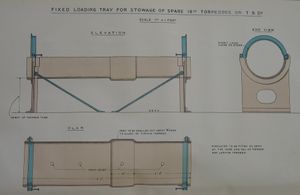River Class Destroyer (1903)
A total of thirty six destroyers of the River Class entered service between 1904 and 1909.
They were designated the "E" class in 1912.[1] Eden, Stour and Test alone had turbine propulsion.
Armament
Guns
Initially, one 12-pdr Q.F. gun and five 6-pdr Q.F. From 1906, they had four 12-pdr Q.F. and no 6-pdr guns.
Torpedoes

Two single 18-in tubes.
Arrangements were made in 1909 to equip the ships with chocks (for 21-inch Mark I or Mark II torpedoes, curiously) or fixed loading trays (for 18-inch torpedoes) for deck storage of a spare torpedo per tube in time of war. This may have forecast hopes to switch to 21-inch torpedoes, as Waveney was testing an experimental 21-inch tube (weight: 2744 pounds), derrick and winch that same year before transferring the equipment to Rocket, the then-tender to Vernon.[3]
Searchlights
The River class were the last British destroyers to use a single searchlight.[4]
Fire Control
By 1915, at least, these ships had fixed voice pipes installed between decks with the last lengths being flexible (one voice pipe for gunnery, one for torpedoes) fitted between bridge and guns, torpedo tubes, and searchlights.[5]
Instruments
Rangefinders
Evershed Bearing Indicators
Gunnery Control
Control Positions
Control Groups
Directors
Torpedo Control
Some of the ships were equipped with Fore Bridge Firing Gear, either upon completion or prior to 1911.[6]
See Also
Footnotes
- ↑ Conway's All the World's Fighting Ships, 1860-1905, p. 99.
- ↑ Annual Report of the Torpedo School, 1909, Plate 15.
- ↑ Annual Report of the Torpedo School, 1909, p. 32.
- ↑ Manual of Gunnery, Vol. III., 1915., p. 161.
- ↑ Manual of Gunnery, Vol. III., 1915., p. 150.
- ↑ Annual Report of the Torpedo School, 1916, p. 31.
Bibliography